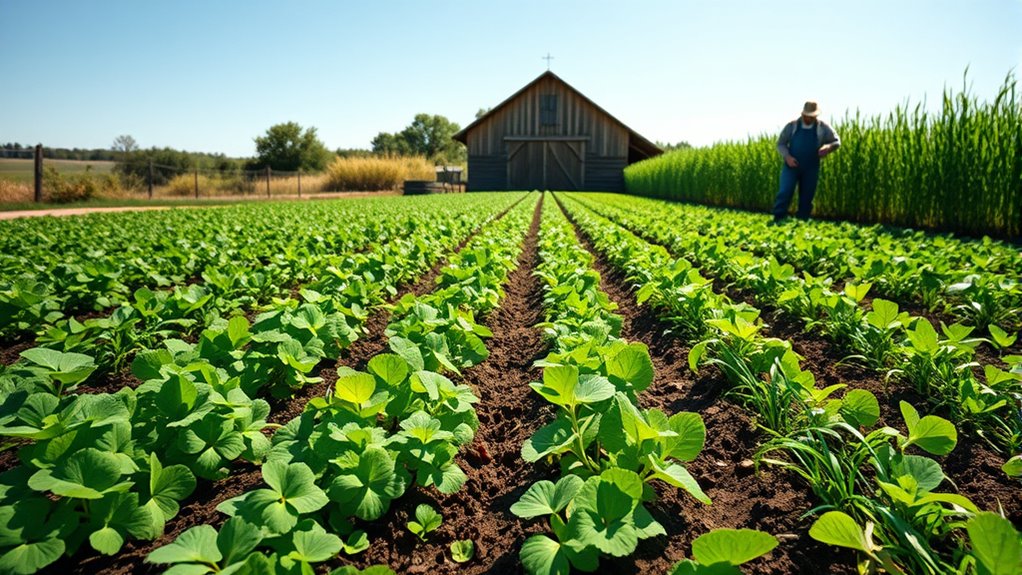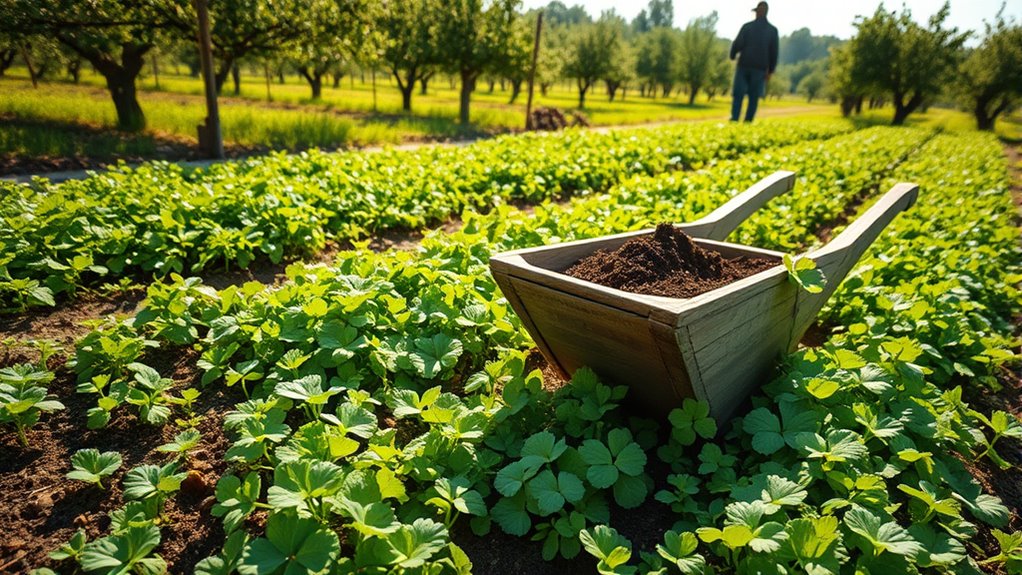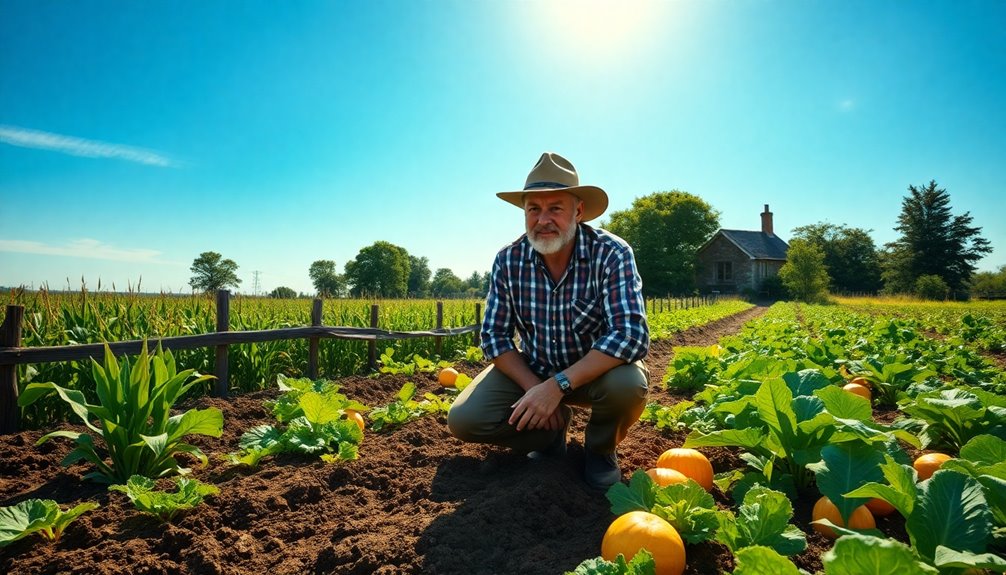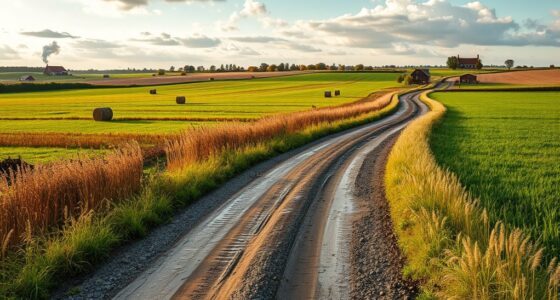Using cover crops and green manure on your small farm helps naturally improve soil fertility, reduce erosion, and boost biodiversity. You can select crops like clover, vetch, or grasses that fix nitrogen and decompose quickly to add organic matter. These practices also control weeds and attract beneficial insects, cutting down on chemical use. Incorporating these methods into your rotation strengthens your soil and crop yields—discover more ways to optimize your farm’s health as you explore further.
Key Takeaways
- Select appropriate cover crops like legumes to naturally fix nitrogen and improve soil fertility.
- Incorporate green manure crops into rotation to boost organic matter and decompose quickly for nutrient release.
- Use cover crops to prevent soil erosion, enhance water retention, and improve soil structure on small plots.
- Attract beneficial insects and limit pest habitats, reducing the need for chemical pest control methods.
- Combine cover cropping with water management practices for optimal soil health and crop productivity.

Implementing cover crops and green manure on a small farm can considerably boost soil health and crop yields. When you choose the right cover crops, you’re enriching your soil’s fertility naturally, which leads to healthier plants and better harvests. Cover crops like clover, vetch, or peas fix nitrogen in the soil, reducing your reliance on chemical fertilizers. This process improves soil structure, increases organic matter, and creates a more resilient environment for your crops to thrive. Not only do these plants boost soil fertility, but they also play a crucial role in pest management. By covering your soil, you limit the habitat for many pests and weeds, reducing their populations before they can cause significant damage. Some cover crops even attract beneficial insects that prey on common pests, creating a natural balance that minimizes pest outbreaks. This integrated approach helps you maintain healthier plants without resorting to chemical interventions, which can be costly and harmful to the environment. Additionally, understanding soil health and how cover crops contribute to it can help you develop a more sustainable farming system. Incorporating soil conservation practices like cover cropping can help prevent erosion and improve overall farm resilience, especially on small plots. Using green manure is another effective way to boost your soil’s health. When you incorporate these crops into your soil after they’ve grown, they decompose quickly, releasing essential nutrients that feed your crops directly. Green manure crops like legumes or grasses are easy to grow and manage, fitting well into a small farm’s rotation. They not only improve soil fertility but also help suppress weeds by outcompeting them for nutrients and space. Plus, the organic matter added from green manure enhances soil’s water retention and aeration, which is critical for young plants’ root development. This practice leads to more vigorous growth and higher yields over time, especially when combined with water management strategies to optimize moisture levels. Incorporating cover crop selection techniques tailored to your specific soil and crop needs can further enhance these benefits. A well-chosen cover crop can also help improve soil microbiology, fostering beneficial microorganisms that support plant health and nutrient cycling.
Frequently Asked Questions
How Do Cover Crops Affect Pest Populations on Small Farms?
You might wonder how cover crops influence pest populations. They can promote pest suppression by increasing crop diversity, which confuses pests and reduces their numbers. Cover crops also attract beneficial insects that prey on pests, creating a natural pest control balance. This integrated approach helps protect your small farm’s crops, reducing the need for chemical interventions and fostering a healthier, more resilient ecosystem.
What Are the Best Cover Crops for Different Soil Types?
Imagine revealing your farm’s potential with the perfect cover crops. The secret lies in your soil’s nutrients—clay, sandy, or loamy—each demands different solutions. For nutrient-rich soils, legumes boost nitrogen; for sandy soils, deep-rooted crops like radishes improve structure. Incorporate crop rotation to keep your soil healthy and productive. Choosing the right cover crops transforms your soil, ensuring lush harvests and long-term sustainability—your farm’s hidden advantage.
How Do Cover Crops Influence Water Retention During Drought?
Cover crops boost soil moisture by reducing evaporation and improving water retention, helping your farm withstand drought. They create a protective mulch layer that keeps the soil moist longer and enhance soil structure, increasing water infiltration. This improves drought resilience, ensuring your plants have access to moisture even during dry spells. By maintaining better soil moisture, you support healthier crops and reduce the need for supplemental watering.
Can Cover Crops Be Used in Organic Farming Systems?
You can absolutely use cover crops in organic farming systems. When selecting cover crops, focus on those that meet organic standards and support your farm’s goals, like improving soil health or suppressing weeds. Proper cover crop selection guarantees you maintain your organic certification while benefiting from natural soil fertility and erosion control. Incorporating these crops into your rotation helps enhance sustainability and aligns with organic practices, making your farm more resilient and productive.
How Long Does It Take to See Soil Health Improvements?
Imagine watching your soil transform, feeling the richness grow beneath your feet. You’ll see soil nutrient changes and increased microbial activity within a few months, as organic matter accumulates and microbes flourish. Consistent cover cropping accelerates these benefits, making your soil healthier faster. With patience and regular practice, you’ll notice better soil structure, higher fertility, and vibrant plant growth, creating a thriving farm ecosystem you can be proud of.
Conclusion
Incorporating cover crops and green manure can boost your soil health and crop yields. Did you know that small farms using these practices see a 20% increase in nitrogen levels within just one season? This simple strategy helps you reduce fertilizer costs and improve sustainability. By planting cover crops, you’re not only protecting your soil from erosion but also creating a healthier, more productive farm. Start integrating these methods today for a greener, more resilient future.










